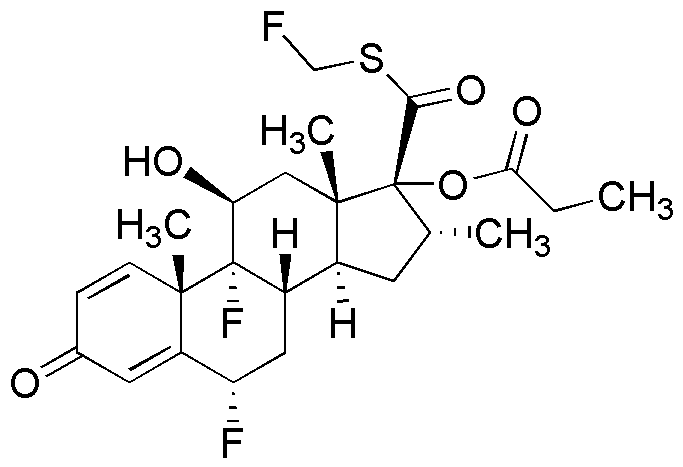Fluticasone propionate is widely utilized in research focused on:
- Respiratory Medicine: Commonly used in inhalers for asthma and chronic obstructive pulmonary disease (COPD), it helps reduce inflammation in the airways, making breathing easier for patients.
- Allergy Treatments: This compound is effective in nasal sprays to alleviate symptoms of allergic rhinitis, providing relief from sneezing, runny nose, and nasal congestion.
- Dermatology: Fluticasone propionate is formulated in topical creams and ointments to treat skin conditions like eczema and psoriasis, helping to reduce inflammation and itching.
- Veterinary Medicine: Used in veterinary formulations, it aids in managing inflammatory conditions in animals, improving their quality of life.
- Research Applications: In laboratory settings, it is often studied for its anti-inflammatory properties, contributing to the development of new therapies for various inflammatory diseases.
General Information
Properties
Safety and Regulations
Applications
Fluticasone propionate is widely utilized in research focused on:
- Respiratory Medicine: Commonly used in inhalers for asthma and chronic obstructive pulmonary disease (COPD), it helps reduce inflammation in the airways, making breathing easier for patients.
- Allergy Treatments: This compound is effective in nasal sprays to alleviate symptoms of allergic rhinitis, providing relief from sneezing, runny nose, and nasal congestion.
- Dermatology: Fluticasone propionate is formulated in topical creams and ointments to treat skin conditions like eczema and psoriasis, helping to reduce inflammation and itching.
- Veterinary Medicine: Used in veterinary formulations, it aids in managing inflammatory conditions in animals, improving their quality of life.
- Research Applications: In laboratory settings, it is often studied for its anti-inflammatory properties, contributing to the development of new therapies for various inflammatory diseases.
Documents
Safety Data Sheets (SDS)
The SDS provides comprehensive safety information on handling, storage, and disposal of the product.
Product Specification (PS)
The PS provides a comprehensive breakdown of the product’s properties, including chemical composition, physical state, purity, and storage requirements. It also details acceptable quality ranges and the product's intended applications.
Certificates of Analysis (COA)
Search for Certificates of Analysis (COA) by entering the products Lot Number. Lot and Batch Numbers can be found on a product’s label following the words ‘Lot’ or ‘Batch’.
*Catalog Number
*Lot Number
Certificates Of Origin (COO)
This COO confirms the country where the product was manufactured, and also details the materials and components used in it and whether it is derived from natural, synthetic, or other specific sources. This certificate may be required for customs, trade, and regulatory compliance.
*Catalog Number
*Lot Number
Safety Data Sheets (SDS)
The SDS provides comprehensive safety information on handling, storage, and disposal of the product.
DownloadProduct Specification (PS)
The PS provides a comprehensive breakdown of the product’s properties, including chemical composition, physical state, purity, and storage requirements. It also details acceptable quality ranges and the product's intended applications.
DownloadCertificates of Analysis (COA)
Search for Certificates of Analysis (COA) by entering the products Lot Number. Lot and Batch Numbers can be found on a product’s label following the words ‘Lot’ or ‘Batch’.
*Catalog Number
*Lot Number
Certificates Of Origin (COO)
This COO confirms the country where the product was manufactured, and also details the materials and components used in it and whether it is derived from natural, synthetic, or other specific sources. This certificate may be required for customs, trade, and regulatory compliance.


